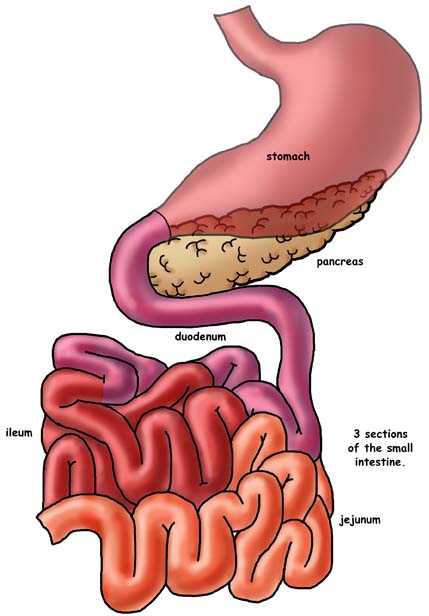

The small intestine is about 6 feet long (2 meters) in an adult. If you could relax all the muscle of the small intestine, you could stretch it out to about 20 feet long (6 meters). The small intestine is a hollow tube that twists and turns in a jumbled mass tucked inside the curve of the large intestine. It’s length is divided into 3 parts: the duodenum, jejunum and ileum.
The small intestine is where digestion is completed and all the food nutrients are absorbed into the blood. The digested food from the stomach has been broken down into a creamy paste, called chyme, which is emptied into the first part of the small intestine – the duodenum. It is here that the pancreas gland secretes pancreatic juice into the chyme to neutralize the acids from the stomach. Bile, made in the liver and stored in the gall bladder, enters here as well. Bile helps break down the fats.
The inner lining of the small intestine has tiny finger-like projections called villi. The villi increase the surface area of the small intestine lining which helps increase the absorption of nutrients from the food materials passing through. The absrobed nutrients pass from the small intestine into capillaries that deliver them to the cells of the body.
LS1.A Structure and Function
K-2 All organisms have external parts that they use to perform daily functions.
3-5 Organisms have both internal and external macroscopic structures that allow for growth, survival, behavior, and reproduction.
6-8 All living things are made up of cells. In organisms, cells work together to form
tissues and organs that are specialized for particular body functions.
9-12 Systems of specialized cells within organisms help perform essential functions of life. Any one system in an organism is made up of numerous parts. Feedback mechanisms maintain an organism’s internal conditions within certain limits and mediate behaviors.
When you research information you must cite the reference. Citing for websites is different from citing from books, magazines and periodicals. The style of citing shown here is from the MLA Style Citations (Modern Language Association).
When citing a WEBSITE the general format is as follows.
Author Last Name, First Name(s). "Title: Subtitle of Part of Web Page, if appropriate." Title: Subtitle: Section of Page if appropriate. Sponsoring/Publishing Agency, If Given. Additional significant descriptive information. Date of Electronic Publication or other Date, such as Last Updated. Day Month Year of access < URL >.
Amsel, Sheri. "Small Intestine" Exploring Nature Educational Resource ©2005-2024. December 13, 2024
< http://www.exploringnature.org/db/view/Small-Intestine >

